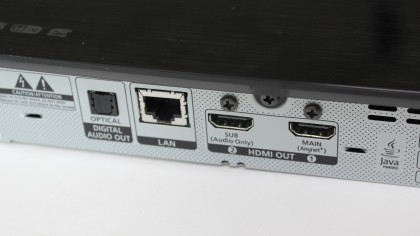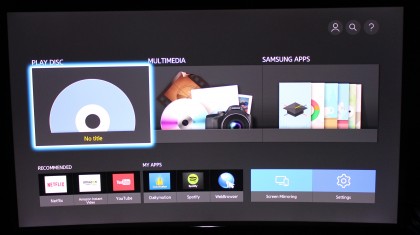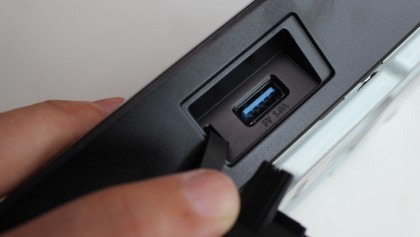TechRadar Verdict
Samsung's stripped back 4K Blu-ray player is just what your Ultra HD TV needs, but early adopters are expected to pay a high price for better pixels.
Pros
- +
Impressive 4K HDR image quality
- +
4K Netflix and Amazon onboard
- +
Two HDMI outputs for AV receiver compatibility
Cons
- -
Journeyman build quality, and noisy
- -
Not a great-sounding music player
- -
Remote uses a coin battery
Why you can trust TechRadar
The UBD-K8500 is Samsung's debut 4K Ultra HD Blu-ray player. It's also the most affordable way into the new disc format right now, undercutting its rival, the Panasonic DMP-UB900, by a considerable margin.
4K Blu-ray, for those late to the party, is a next-generation disc format that offers four times the pixel density of HD Blu-ray and HDR (High Dynamic Range), for greater contrast and deeper colours. The launch catalogue of 4K discs may be limited, but in terms of eye candy there's nothing quite like it.
That said, like any new format, the cost of admission isn't cheap – Samsung expects you to pay a princely premium for the privilege of watching your favorite movies and shows in Ultra HD.
Design
Cosmetically, the K8500 is disarmingly mainstream. Despite its vanguard status and £430 / $399 / AU$596 price ticket, there are no obvious high-end trappings here.
Connectivity includes two HDMI outputs, designated Main and Sub (Audio Only). These allow the player to be used with a non-4K compatible AV receiver, if required (just route audio via the amplifier, while video is delivered to the screen direct).

If your kit is up to snuff, you'll only need the main HDMI output. There's also Ethernet LAN and an optical digital audio output, however, analogue audio outputs are AWOL. The K8500 also has Wi-Fi onboard, in case your entertainment centre is a bit too far from your router.
The player ships with a stubby little remote control, which rather infuriatingly is powered by a coin battery rather than regular, ubiquitous AAAs.
The UBD-K8500 is, of course, more than just a disc spinner: it's also a media player with connected streaming services like Netflix, Amazon Instant Video and Hulu.
Interestingly, the Blu-ray player doesn't use Samsung's Tizen smart TV platform. What you'll find on the K8500 is Samsung's older Smart Hub, with a lick of paint.
The Smart Hub user interface is easy enough to navigate, and the player supports Netflix and Amazon Instant Video 4K streams, and has YouTube, a web browser, Spotify, Deezer, BFI Player and Daily Motion on tap. Need more? Hop over to Samsung's app store. Curiously, the ubiquitous BBC iPlayer is missing though.

High-performance picture quality
Obviously, the key reason to invest in a 4K Blu-ray player is picture quality, and the K8500's images look reassuringly fabulous; when it comes to fine detail and colour, native 4K discs edge ahead of UHD offered by Netflix and Amazon.
But there are caveats.
4K Blu-ray is more challenging proposition than it might at first appear. Simply choosing the best mode to watch UHD HDR content is a puzzle – and that's without any additional complications offered by your 4K display of choice.
4K HDR rewrites the rulebook of AV set-up. It's not possible to use conventional test patterns to balance an image for HDR viewing – they're simply inappropriate. So your best guide is the modes the player itself offers, coupled to the HDR input mode of the screen itself, which is usually locked to ensure the integrity of the HDR signal.
The K8500 has a variety of picture modes available via the Tools menu. These comprise Dynamic, Standard, Movie and User. You might naturally assume that the Movie mode is the best choice. However, test patterns reveal that the player is muting out a lot of high frequency information in this playback mode. If you want to extract every last detail from your 4K discs, it's probably not the best place to go.
It might not have been your first choice, but the Standard setting actually pulls out more subtleties. Though, that said, the Movie mode does offer the best contrast/brightness combination.
Choosing between these settings largely comes down to preference and content. For sheer 4K HDR pizzazz, however, I think Standard has it.

The catch is that, if you then watch a standard Blu-ray using the same setting via the same HDMI input on your TV, the image is significantly degraded. Without HDR10 metadata to guide the set, your telly is likely to scale the image as bright as it can (for this audition, I used a Samsung JS9000). The Man from U.N.C.L.E (Blu-ray) opens in after dark East Berlin, but all the artful shadows of the cinematography were absent.
One way to address this is to exploit the player's User setting. This allows you to dial back brightness and contrast for 1080p Blu-rays (I found about -5 and 0, respectively does it, but this may vary depending on your display). But changing these settings means that you'll need to remember to switch viewing modes depending on your disc format.
On the audio front, the K8500 is rather ordinary, exhibiting a metallic, hashy tone with two channel PCM. Dirty Boys (The Next Day, David Bowie) proves too brittle to really engage. Now, in a TV/soundbar environment this will go unnoticed, but with demanding electronics it becomes rather obvious.
Of course, bitstreamed Dolby and DTS soundtracks are delivered to an AV receiver just as efficiently as from any other player, so that's not an issue with Blu-ray movies.
It's worth taking some time to explore the Sound menu. Home cinema users should ensure that the Digital Output of the player is set to 'Bitstream (unprocessed)', and make sure Dynamic Range Control is set to Off.
While the player may not win merit points for construction, it's whiplash fast. Goldfinger, a Java-heavy Blu-ray, goes from tray to menu in just 36 seconds. Lou Reed's Berlin, a stripped back concert disc, was menu-ready in just 25 seconds.
Steve has been writing about AV and home cinema since the dawn of time, or more accurately, since the glory days of VHS and Betamax. He has strong opinions on the latest TV technology, Hi-Fi and Blu-ray/media players, and likes nothing better than to crank up his ludicrously powerful home theatre system to binge-watch TV shows.

